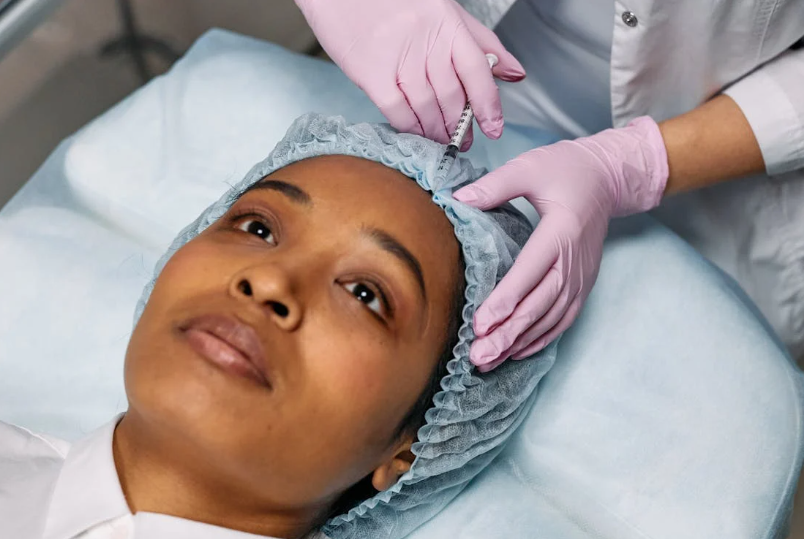
The Origin of Botox
Botox’s roots are deeper than most realize. While commonly associated with cosmetic treatments, it was initially used for medical purposes. Derived from Clostridium botulinum, a bacterium discovered in the 1890s, Botox was first employed to treat strabismus (crossed eyes) in the 1980s. Its ability to relax muscles proved valuable beyond its original use.
Botox’s medical applications expanded rapidly. Researchers discovered it could alleviate conditions like chronic migraines and severe sweating. These unexpected benefits paved the way for its later cosmetic applications, further cementing its place in both medicine and aesthetics.
Understanding Botox’s history helps us appreciate its versatility. Its medical origins underscore the scientific rigor behind its development, ensuring its efficacy and safety in various treatments today.
How Botox Works
Botox operates by temporarily paralyzing muscles. When injected, it blocks nerve signals to the muscles, preventing them from contracting. This relaxation effect is what smooths out wrinkles and fine lines, giving the skin a youthful appearance.
This mechanism also explains Botox’s non-cosmetic uses. For instance, in treating chronic migraines, Botox reduces muscle tension around the head and neck, alleviating pain. Similarly, for hyperhidrosis (excessive sweating), it inhibits sweat gland activity.
The beauty of Botox lies in its precision. Doctors can target specific muscles, ensuring only the desired areas are affected while surrounding tissues remain untouched. This targeted approach minimizes risks and maximizes results.
Botox Beyond Beauty
Contrary to popular belief, Botox’s benefits extend far beyond wrinkle reduction. It’s a powerful tool in the medical field, addressing various conditions that impact quality of life. For example, Botox is effective in treating muscle stiffness and spasms associated with cerebral palsy.
Additionally, Botox plays a role in managing overactive bladder symptoms. By relaxing the bladder muscle, it can reduce urinary incontinence episodes, offering significant relief to affected individuals.
Botox’s ability to alleviate chronic pain conditions, such as temporomandibular joint disorders (TMJ), further showcases its versatility. These applications highlight Botox’s potential to improve health and well-being in ways that many might not expect.
Finding the Right Provider
Choosing the right provider is crucial for a successful Botox experience. Look for a board-certified dermatologist or plastic surgeon with extensive experience in administering Botox.
Check reviews and ask for before-and-after photos of previous patients. A reputable provider will be transparent about their qualifications and patient outcomes.
Consultations with professionals like those at Rejuvenate Austin are an excellent opportunity to ask questions and discuss goals. A good provider will listen to your concerns, explain the procedure in detail, and create a customized treatment plan.
The Procedure Explained
Understanding the Botox procedure can demystify the treatment process. It typically involves a series of small injections administered by a trained professional. The entire session usually lasts about 10-15 minutes, making it a convenient option for those with busy schedules.
Preparation is minimal. Patients are advised to avoid certain medications that can increase bruising risk, such as aspirin or ibuprofen, for a few days before the procedure. The actual injection process is relatively painless, with most patients describing the sensation as a tiny pinch.
Post-treatment care is straightforward. Patients are typically encouraged to avoid lying down or strenuous activities for a few hours to ensure the Botox settles into the targeted muscles. Results start to appear within a few days and can last several months.
Potential Side Effects
Like any medical procedure, Botox has potential side effects. Common reactions include minor swelling, redness, or bruising at the injection site. These effects are generally short-lived, resolving within a few days.
More serious side effects are rare but possible. They can include allergic reactions, muscle weakness, or difficulty swallowing. It’s crucial to choose a qualified and experienced practitioner to minimize these risks. They can ensure the treatment is administered safely and effectively.
Knowing the potential side effects allows patients to make informed decisions. It’s always best to discuss any concerns with the treating physician before undergoing Botox treatment.
Who Can Benefit from Botox?
Botox isn’t just for those seeking to reduce signs of aging. Many individuals with medical conditions can benefit from its therapeutic properties. For instance, people with chronic migraines often experience significant relief with Botox treatments.
Individuals with muscle disorders, such as spasticity, also find Botox helpful. By relaxing affected muscles, Botox can improve mobility and reduce discomfort.
Furthermore, those with hyperhidrosis can benefit greatly. Botox’s ability to control excessive sweating can boost confidence and improve daily life quality. This wide range of applications makes Botox a versatile option for many.
Botox vs. Fillers
It’s essential to distinguish between Botox and dermal fillers, as they serve different purposes. Botox relaxes muscles to smooth wrinkles, primarily on the upper face, such as forehead lines and crow’s feet.
Dermal fillers, on the other hand, add volume to areas like the cheeks, lips, and under-eye hollows. They can also fill deeper wrinkles that Botox might not address. Fillers are often made from hyaluronic acid, a substance naturally found in the skin.
Understanding the difference helps patients choose the right treatment for their needs. Some may even benefit from a combination of both for optimal results.
Maintaining Results
Maintaining Botox results involves following a few simple guidelines. First, adhere to the post-treatment care instructions provided by your practitioner. This may include avoiding strenuous activities and certain facial expressions for a brief period.
Protecting your skin from sun exposure is essential. Sun damage can accelerate aging, diminishing Botox’s effects. Use sunscreen daily and wear protective clothing when outdoors.
Consider a healthy lifestyle, including a balanced diet and regular exercise. Staying hydrated and getting enough sleep can enhance your skin’s overall health, complementing Botox’s effects.
Botox is more than a cosmetic treatment; it’s a versatile tool with a rich history and numerous applications. From its medical origins to its current uses, Botox continues to improve lives and boost confidence.


